
The Nymphalidae are the largest family of butterflies, with more than 6,000 species distributed throughout most of the world. Belonging to the superfamily Papilionoidea, they are usually medium-sized to large butterflies. Most species have a reduced pair of forelegs and many hold their colourful wings flat when resting. They are also called brush-footed butterflies or four-footed butterflies, because they are known to stand on only four legs while the other two are curled up; in some species, these forelegs have a brush-like set of hairs, which gives this family its other common name. Many species are brightly coloured and include popular species such as the emperors, monarch butterfly, admirals, tortoiseshells, and fritillaries. However, the under wings are, in contrast, often dull and in some species look remarkably like dead leaves, or are much paler, producing a cryptic effect that helps the butterflies blend into their surroundings.
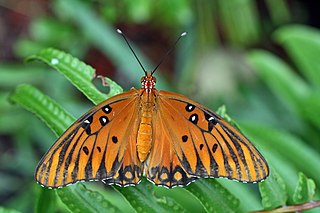
The Gulf fritillary or passion butterfly is a bright orange butterfly in the subfamily Heliconiinae of the family Nymphalidae. That subfamily was formerly set apart as a separate family, the Heliconiidae. The Heliconiinae are "longwing butterflies", which have long, narrow wings compared to other butterflies.

The morpho butterflies comprise many species of Neotropical butterfly under the genus Morpho. This genus includes more than 29 accepted species and 147 accepted subspecies, found mostly in South America, Mexico, and Central America. Morpho wingspans range from 7.5 cm (3.0 in) for M. rhodopteron to 20 cm (7.9 in) for M. hecuba, the imposing sunset morpho. The name morpho, meaning "changed" or "modified", is also an epithet. Blue morphos are severely threatened by the deforestation of tropical forests and habitat fragmentation. Humans provide a direct threat to this genus because their beauty attracts artists and collectors from all over the globe who wish to capture and display them. Aside from humans, birds like the jacamar and flycatcher are the adult butterfly’s natural predators.

The superfamily Papilionoidea contains all the butterflies except for the moth-like Hedyloidea.

The Nymphalinae are a subfamily of brush-footed butterflies. Sometimes, the subfamilies Limenitidinae, and Biblidinae are included here as subordinate tribe(s), while the tribe Melitaeini is occasionally regarded as a distinct subfamily. Their phylogenetics can be traced back to the Cretaceous Terrestrial Revolution after the “Cretaceous-Paleogene (K-Pg) mass extinction, followed by repeated dispersals into the rest of the Old World and the New World during various periods beginning in Eocene

Hamearis lucina, the Duke of Burgundy, the only member of the genus Hamearis, is a European butterfly in the family Riodinidae. For many years, it was known as the "Duke of Burgundy fritillary", because the adult's chequered pattern is strongly reminiscent of "true" fritillaries of the family Nymphalidae.

Hypolimnas bolina, the great eggfly, common eggfly, varied eggfly, or in New Zealand the blue moon butterfly, is a species of nymphalid butterfly found from Madagascar to Asia and Australia.
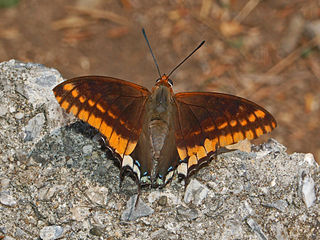
Charaxes jasius, the two-tailed pasha, is a butterfly in the family Nymphalidae. It is the only European species of the genus Charaxes. Divergence of the Mediterranean species C. jasius from the last common ancestor with its closest related species still flying in the Afrotropical realm most probably occurred around 2 mya, i.e. during the Pliocene.

Adelpha californica, the California sister, is a species of butterfly in the family Nymphalidae. They are common in California, but can also be found in western Nevada and Oregon, as well as in northern Baja California. The upper surfaces of their wings are dark brown to black with wide cream white bands dissecting both wings and two orange patches near the tips of the forewings. The underside is variously colored with browns, blue, orange, and white. A. californica is unpalatable to predators and is part of a large mimicry complex.

The rajah and pasha butterflies, also known as emperors in Africa and Australia, make up the huge type genus of the brush-footed butterfly subfamily Charaxinae, or leafwing butterflies. They belong to the tribe Charaxini, which also includes the nawab butterflies (Polyura). Charaxes are tropical Old World butterflies, with by far the highest diversity in sub-Saharan Africa, a smaller number from South Asia to Melanesia and Australia, and a single species in Europe. They are generally strong flyers and very popular among butterfly collectors.

Junonia is a genus of nymphalid butterflies, described by Jacob Hübner in 1819. They are commonly known as buckeyes, pansies or commodores. This genus flies on every continent except Antarctica and Europe. The genus contains roughly 30 to 35 species.

Kallima, known as the oakleaf or oak leaf butterflies, is a genus of butterflies of the subfamily Nymphalinae in the family Nymphalidae. They are found in east, south and southeast Asia. Their common name is a reference to the lower surface of their wings, which is various shades of brown like a dead leaf.

Doleschallia is a genus of butterflies of the subfamily Nymphalinae in the family Nymphalidae. With their wings closed Doleschallia resemble dead leaves. Another Indo-Australian genus Kallima, and the African genera Kamilla, Mallika and Kallimoides are collectively known as dead leaf butterflies.

Charaxes castor, the giant emperor or giant charaxes, is a butterfly of the family Nymphalidae. It is found throughout the Afrotropical realm below the Sahel.
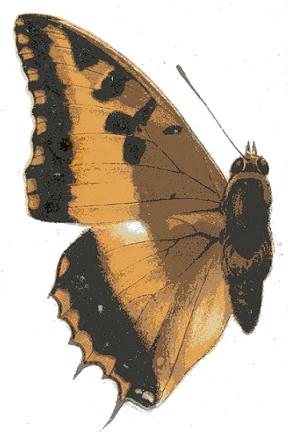
Charaxes druceanus, the silver-barred emperor or silver-barred charaxes, is a butterfly of the family Nymphalidae. It is found throughout tropical Africa.

Mechanitis is a genus of butterflies in the tribe Ithomiini, commonly known as tigerwings. They were named by Johan Christian Fabricius in 1807. They are in the brush-footed butterfly family, Nymphalidae. Members of the genus Mechanitis were named for the machine-like metallic appearance of the chrysalis in certain species such as the Mechanitis polymnia. The chrysalises have a reflective chitin coating with a metallic appearance.
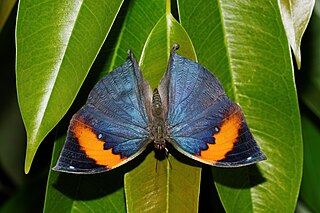
Kallima paralekta, the Indian leafwing or Malayan leafwing, is a species of brush-footed butterfly of the genus Kallima. Despite its common names, it is not found in India or Malaysia, but is endemic to Java and Sumatra of Indonesia. Like other members of its genus, it is remarkable for its strong resemblance to a dead leaf when its wings are folded. It was one of the species encountered by the British naturalist Alfred Russel Wallace in his travels in maritime Southeast Asia. It is mentioned in his famous 19th-century work The Malay Archipelago as one of the best examples of protective camouflage achieved through natural selection.

Kallimoides is a monotypic genus of butterflies in the family Nymphalidae. It contains only one species, Kallimoides rumia, the African leaf butterfly. It is found in Guinea, Sierra Leone, Liberia, Ivory Coast, Ghana, Nigeria, Bioko, Cameroon, Gabon, the Republic of the Congo, Angola, the Central African Republic, the Democratic Republic of the Congo, Uganda, Rwanda, Burundi and Tanzania. The habitat consists of forests.
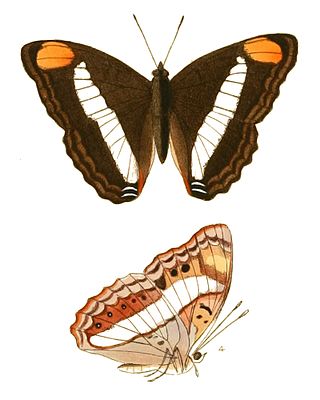
Doxocopa pavon, the Pavon emperor or Pavon, is a species of butterfly in the family Nymphalidae. They can be found from Paraguay in South America up to Texas in the southern United States. They are generally brown in their overall coloration, with two bands of white straddling the middle of the upper surfaces of the wings, and a patch of orange on the tips of their forewings. The upper surfaces of the wings of the males are overlaid by an iridescent blue-purple sheen. The females of the species closely resemble members of the unrelated genus Adelpha.

Thauria or the junglekings is a genus of butterflies in the family Nymphalidae. The genus ranges from Burma to Borneo. The butterflies are large and brightly coloured on the dorsal surface. There is a transverse white stripe on the forewing and one or two white apical spots. The hindwing has a broad yellow margin. The ventral wing surfaces are disruptively patterned and look like dead leaves, allowing the butterflies to blend into leaf litter on the forest floor. Cryptic ventral patterns have arisen multiple times in various forest-floor dwelling groups of Nymphalidae.



















